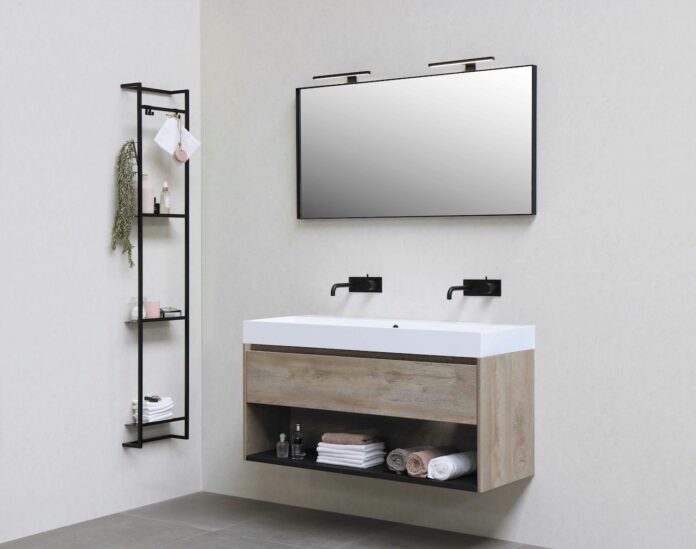Enhance your bathroom’s appeal with a stylish wooden bath panel, combining warmth, elegance, and functionality. The natural grains and rich textures of timber create a serene, spa-like ambiance, instantly elevating your space. This feature adds both charm and practicality, making it an excellent choice for any bathroom.
Wooden panels suit a variety of design styles, from rustic charm to modern sophistication. Whether you prefer the timeless beauty of oak, the rich tones of walnut, or the sleek finish of bamboo, these options blend effortlessly with a wide range of interiors. Their versatility ensures they complement any decor seamlessly.
Pairing wood with materials like stone or metal further enhances the visual appeal. The combination creates a balanced, cohesive look that elevates your bathroom’s overall aesthetic. This adaptability makes wooden accents a smart and flexible design choice for any setting.
Beyond their aesthetic value, these panels transform your bathroom into a cozy and inviting retreat. Their natural elegance and timeless appeal foster a calming atmosphere while ensuring your space feels both luxurious and functional. Incorporating a wood panel is a simple yet impactful way to upgrade your bathroom into a personal oasis.
In this article, the bathroom specialists Ability Bathe Devon will guide you on selecting the best wood for your bath panel, preparing your bathroom for installation, and customizing the panel to suit your style while ensuring durability and moisture resistance. We will also compare fixed and removable panels, explore design integrations, and share maintenance tips to keep your bath panel beautiful and functional for years.
Choosing the Right Type of Wood for Your Bath Panel
When selecting a wooden bath panel, it’s essential to consider various types of wood that are well-suited for bathroom environments. Oak, known for its durability and distinct grain patterns, offers a timeless appeal that complements both traditional and modern designs. Its natural resistance to moisture makes it a popular choice for wet areas.
Walnut, on the other hand, is prized for its rich, dark tones and luxurious appearance. This hardwood adds a touch of elegance and warmth, making it ideal for a sophisticated bathroom setting. However, it typically requires more maintenance than oak to keep its finish looking fresh.
Bamboo is another excellent option, especially for eco-conscious homeowners. As a rapidly renewable resource, bamboo is not only sustainable but also surprisingly durable. Its unique linear grain and light color can bring a contemporary flair to your bath space while providing decent moisture resistance.
When choosing wood, think about moisture resistance, color, and texture. Tighter grains resist humidity better, and lighter tones can make a small bathroom look bigger. Picking a wood that matches your style and bathroom needs will ensure your bath panel looks great and works well for years.
Preparing Your Bathroom for a Wooden Bath Panel
Installing a wooden bath panel requires careful preparation to ensure a successful and lasting installation. Begin by measuring the bath area accurately, taking note of the length, width, and height. This measurement will guide you in selecting a panel that fits perfectly and complements your bathroom’s dimensions. Assess existing fittings, such as plumbing fixtures and towel racks, to ensure they do not interfere with the new panel.
Proper ventilation is crucial in a bathroom environment, especially when working with wood. Humidity from showers or baths can lead to warping and decay over time. Ensure your bathroom is well-ventilated, either through windows or a reliable exhaust fan, to minimize moisture accumulation. Additionally, consider using a dehumidifier if your bathroom tends to retain excess humidity, as this will help maintain a stable environment for the wood.
Waterproofing is another critical step in preparing your bathroom. Before installing the wooden panel, apply a high-quality waterproof membrane or sealant to the wall area behind the panel. This will provide an extra layer of protection against moisture, ensuring that the wood remains in good condition.
Choosing the right wood finish is equally important. Opt for finishes specifically designed for humid environments, such as marine-grade varnishes or specialized wood oils. These finishes offer durability and protection against water damage, ensuring the wood retains its beauty over time.
Customising the Wooden Bath Panel for Your Space
Customising a wooden bath panel allows you to create a unique feature that perfectly fits your bathroom’s style and dimensions. Start by determining the appropriate panel height and thickness to ensure a seamless integration with your bathtub and surrounding fixtures. A thicker panel can add a more substantial look, while a slimmer design may create a sleek, modern appearance.
Edge finishes also play a significant role in the overall aesthetic. Consider options like rounded edges for a softer look or sharp, clean lines for a contemporary feel. These choices can dramatically influence the visual impact of the panel.
Bespoke touches can further enhance both design and functionality. Selecting specific stains can bring out the wood’s natural grain and complement existing decor, whether you prefer a light, airy finish or a dark, rich tone. Additionally, incorporating storage elements, such as built-in shelves or hidden compartments, can boost utility while keeping the space organized and clutter-free.
Protecting the Wooden Bath Panel from Moisture
Protecting a wooden bath panel from moisture is essential to ensure its longevity and maintain its aesthetic appeal. The first step is to choose high-quality waterproof finishes. These finishes not only enhance the wood’s natural beauty but also provide a barrier against water damage. Options like marine varnish or specially formulated wood sealants are excellent choices, as they are designed to withstand high humidity and splashes from the bath.
In addition to initial waterproofing, regular maintenance is crucial. Re-sealing the wood every few years helps to replenish the protective layer and ensures that moisture doesn’t penetrate the wood fibers. When re-sealing, thoroughly clean the panel first to remove any grime or buildup, allowing the sealant to adhere better.
Another vital practice is to respond quickly to any water spills or leaks. Wipe up excess water immediately to prevent pooling, which can lead to warping or mold growth. Using bath mats or towels strategically placed around the tub can help absorb splashes and reduce moisture exposure.
Additionally, ensuring proper ventilation in your bathroom can help mitigate humidity levels. Installing an exhaust fan or leaving windows open when possible will allow moisture to escape, further protecting your wooden bath panel.
Choosing Between a Fixed or Removable Wooden Panel
When selecting a wooden bath panel, homeowners often face the choice between a fixed or removable option. Each design offers distinct benefits that cater to different needs and preferences.
A fixed wooden panel creates a seamless and polished look, enhancing the overall aesthetic of the bathroom. This option often integrates beautifully with the surrounding decor, giving the space a cohesive and luxurious feel. Fixed panels typically require less maintenance over time, as they do not have moving parts that may wear out or require adjustments.
On the other hand, a removable wooden panel offers practical advantages, particularly for those who anticipate needing access to plumbing or other bathroom fixtures. This design allows for easy removal, making it convenient to perform repairs, maintenance, or upgrades without extensive dismantling. Homeowners can easily lift off the panel to reach pipes or access plumbing components, ensuring that any necessary work can be completed swiftly.
When making a decision, clients should consider their specific needs and potential future maintenance requirements. If plumbing access is a priority, a removable panel is advisable.
Integrating Wooden Bath Panels with Bathroom Design Themes
Integrating a wooden bath panel into various bathroom design themes can enhance the overall aesthetic and create a cohesive look. For minimalist designs, opt for light-colored woods like birch or bamboo, which maintain an airy feel while adding warmth. Simple lines and finishes can help emphasize the clean, uncluttered nature of minimalism.
In a rustic bathroom, heavier woods like reclaimed oak or walnut can be used to evoke a sense of warmth and coziness. Pairing the wooden panel with natural stone tiles or distressed metal fixtures will create a charming, earthy vibe that complements the rustic theme beautifully.
For a contemporary style, a sleek wooden panel can add a striking contrast against glossy ceramics or modern metal accents. Dark woods with rich grains can provide a sophisticated touch, making a bold statement without overwhelming the space.
Maintaining the Wooden Bath Panel for Long-Term Beauty
Maintaining a wooden bath panel is essential for preserving its beauty and ensuring its longevity. Regular care helps prevent issues like warping, fading, and moisture damage, keeping your panel looking its best for years to come.
1. Use Mild Cleaners
When cleaning the wooden panel, opt for mild, pH-balanced cleaners specifically designed for wood. Avoid harsh chemicals or abrasive cleaners, as these can strip the finish and damage the wood. A gentle soap diluted in warm water is often sufficient for regular cleaning.
2. Wipe Dry After Use
After each bath or shower, take a moment to wipe the wooden panel dry with a soft cloth. This practice helps to remove excess moisture, reducing the risk of mold and mildew growth. Regular drying can also prevent the wood from absorbing too much water, which can lead to warping over time.
3. Periodic Resealing
Depending on the finish applied to the wood, periodic resealing may be necessary. This typically involves reapplying a water-resistant sealant or finish every one to three years, or as recommended by the product manufacturer. Resealing helps protect the wood from moisture and enhances its natural beauty.
4. Inspect Regularly
Regularly inspect the panel for signs of wear or damage. Look for any cracks, splits, or areas where the finish has worn off. Addressing minor issues promptly can prevent more extensive damage in the future.
5. Avoid Direct Heat Sources
Keep the wooden panel away from direct heat sources, such as radiators or heating vents, as this can dry out the wood and cause cracking.
Conclusion
A wooden bath panel adds warmth and elegance, transforming your bathroom into a stylish and inviting space. With the right wood, thoughtful design, and proper care, it becomes a functional and enduring feature that enhances both aesthetics and practicality for years to come.







